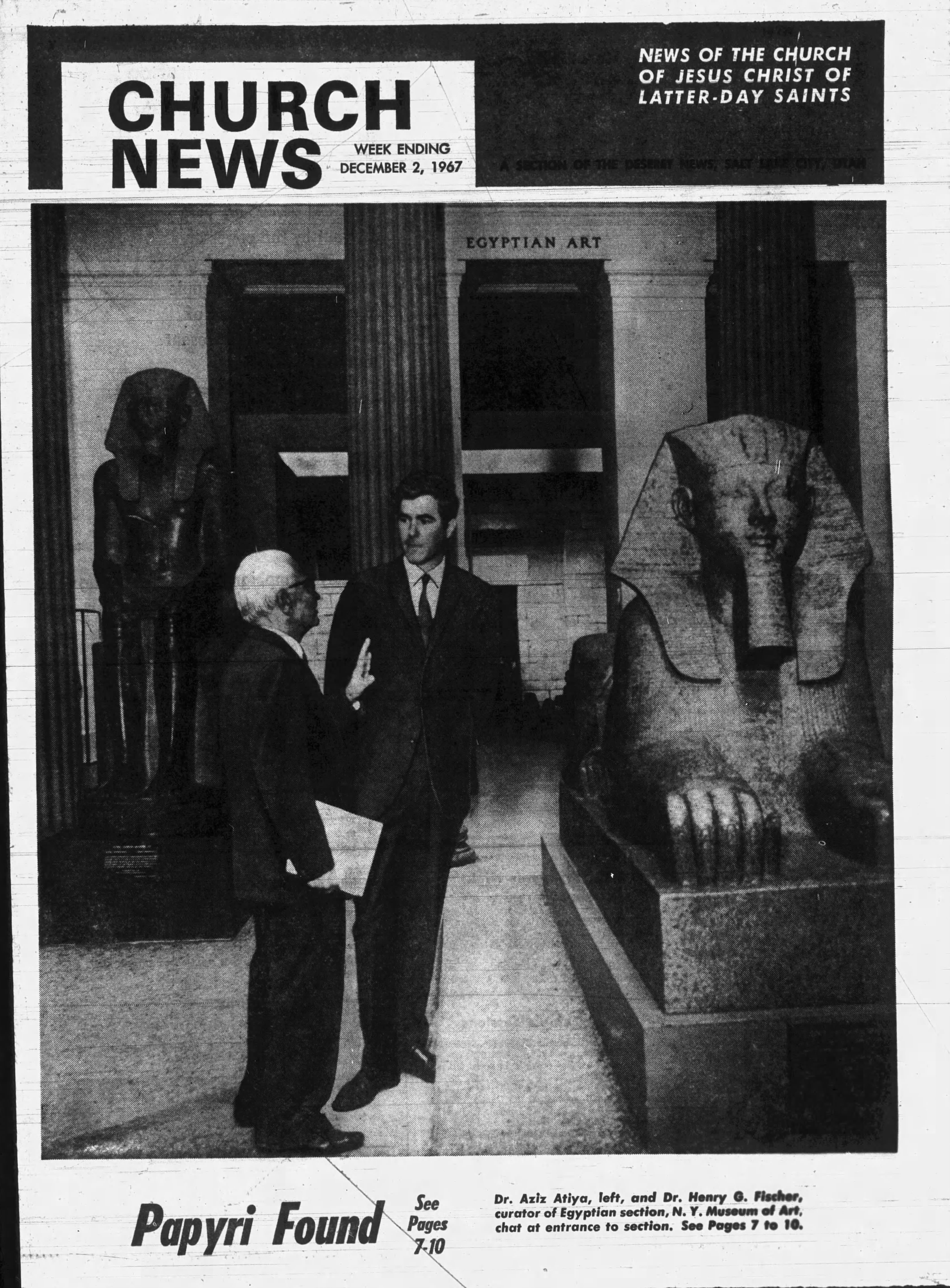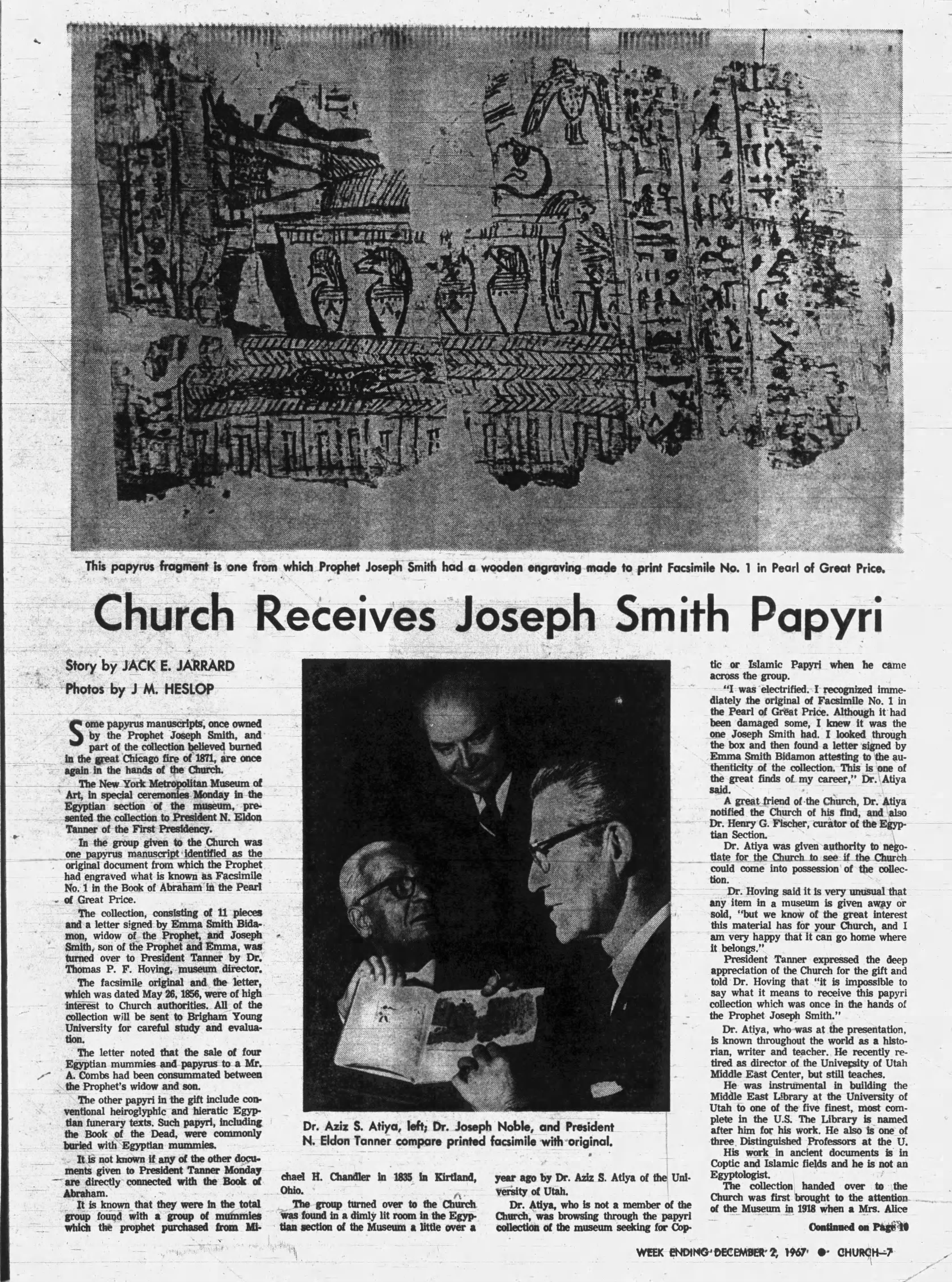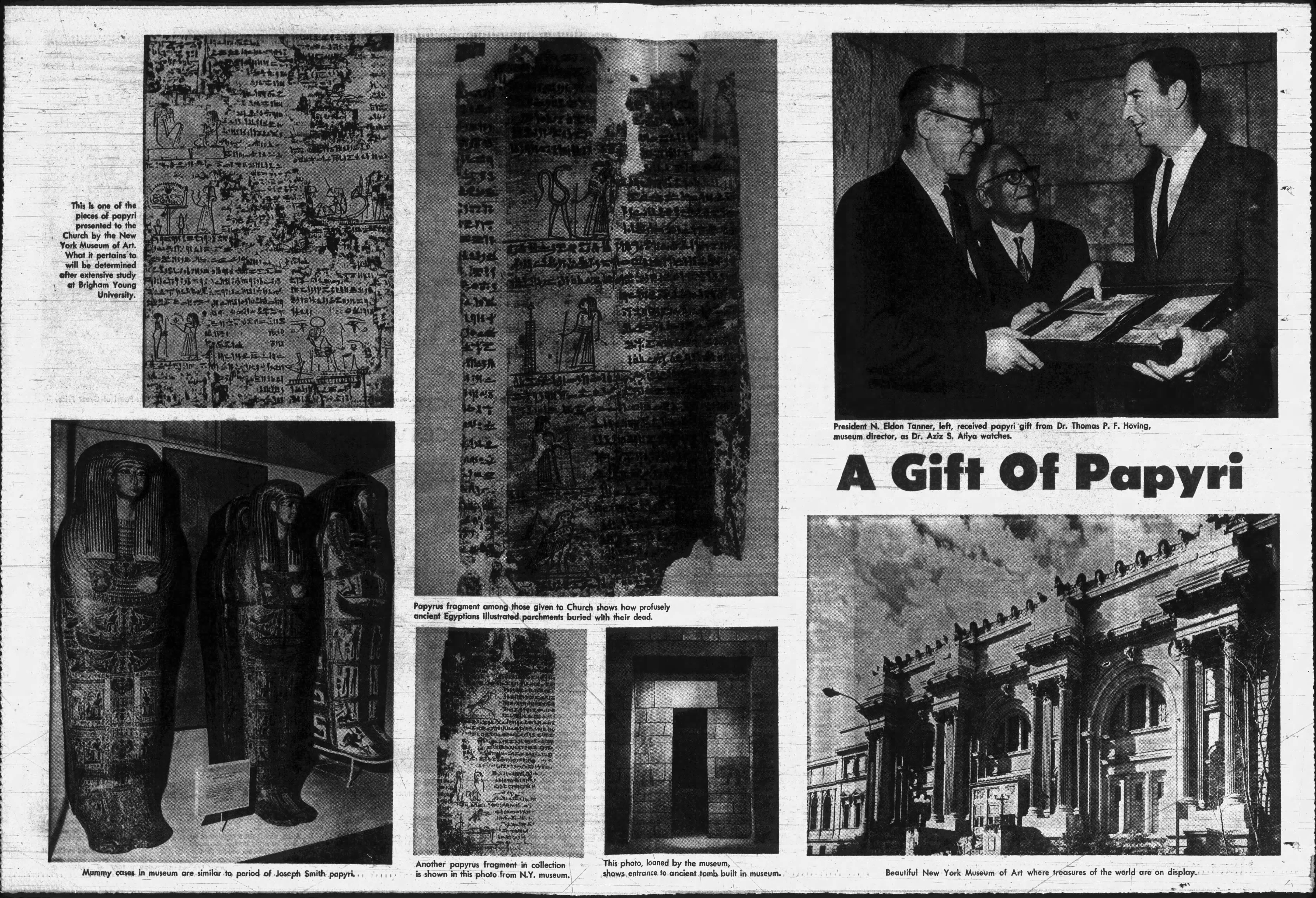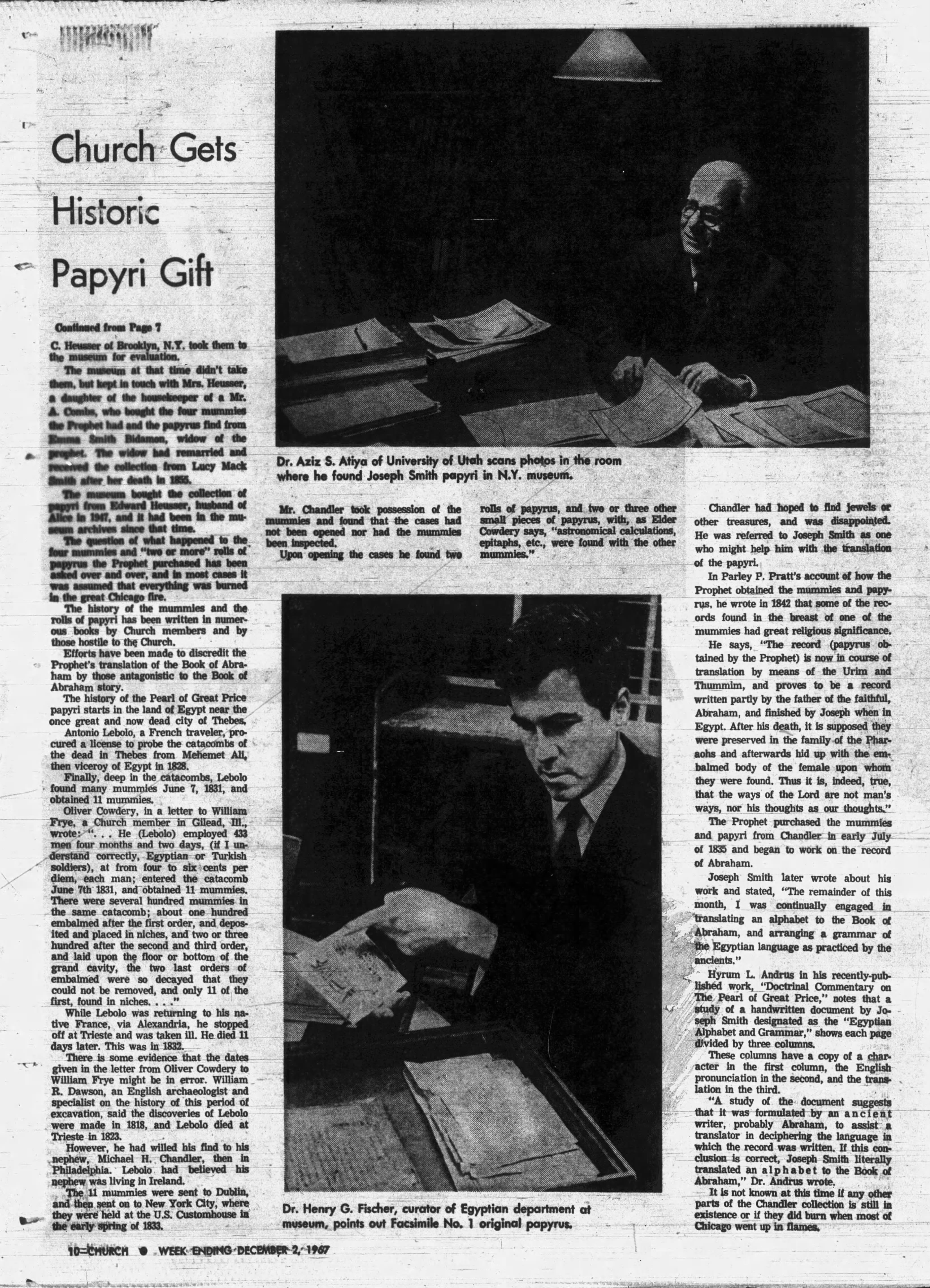Church News reports on the recovery of the Joseph Smith Papyri.
- Type
- News (traditional)
- Source
- Jack E. Jarrard LDS
- Hearsay
- Journalism
- Reference
Jack E. Jarrard, "Church Receives Joseph Smith Papyri," Church News, December 2, 1967, 7–10
- Scribe/Publisher
- The Church News
- People
- Alice C. Heusser, Aziz S. Atiya, Emma Hale Smith, Thomas P. F. Hoving, Antonio Lebolo, N. Eldon Tanner, Michael Chandler, Joseph Smith, Jr., Jack E. Jarrard, William R. Dawson, Oliver Cowdery, Lucy Mack Smith, Joseph Smith III, Edward Heusser, Henry George Fischer, Hyrum L. Andrus, William Frye, Parley P. Pratt
- Audience
- Latter-day Saints, Reading Public
- Transcription
Some papyrus manuscripts, once owned by the Prophet Joseph Smith, and part of the collection believed burned in the great Chicago fire of 1871, are once again in the hands of the Church.
The New York Metropolitan Museum of Art, in special ceremonies Monday in the Egyptian section of the museum, presented the collection to President N. Eldon Tanner of the First Presidency.
In the group given to the Church was one papyrus manuscript identified as the original document from which the Prophet had engraved what is known as Facsimile No. 1 in the Book of Abraham in the Pearl of Great Price.
The collection, consisting of 11 pieces and a letter signed by Emma Smith Bidamon, widow of the Prophet, and Joseph Smith, son of the Prophet and Emma, was turned over to President Tanner by Dr. Thomas P. F. Hoving, museum director.
The facsimile original and the letter, which was dated May 26, 1856, were of high interest to Church authorities. All of the collection will be sent to Brigham Young University for careful study and evaluation.
The letter noted that the sale of four Egyptian mummies and papyrus to a Mr. A. Combs had been consummated between the Prophet's widow and son.
The other papyri in the gift include conventional heiroglyphic and hieratic Egyptian funerary texts. Such papyri, including the Book of the Dead, were commonly buried with Egyptian mummies.
It is not known if any other documents given to President Tanner Monday are directly connected with the Book of Abraham.
It is known that they were in the total group found with a group of mummies which the prophet purchased from Michael H. Chandler in 1835 in Kirtland, Ohio.
The group turned over to the Church was found in a dimly lit room in the Egyptian section of the Museum a little over a year ago by Dr. Aziz S. Atiya of the University of Utah.
Dr. Atiya, who is not a member of the Church, was browsing through the papyri collection of the museum seeking for Coptic or Islamic Papyri when he came across the group.
"I was electrified. I recognized immediately the original of Facsimile No. 1 in the Pearl of Great Price. Although it had been damaged some, I knew it was the one Joseph Smith had. I looked through the box and then found a letter signed by Emma Smith Bidamon attesting to the authenticity of the collection. This one of the great finds of my career," Dr. Atiya said.
A great friend of the Church, Dr. Atiya notified the Church of his find, and also Dr. Henry G. Fischer, curator of the Egyptian Section.
Dr. Atiya was given authority to negotiate for the Church to see if the Church could come into possession of the collection.
Dr. Hoving said it is very unusual that any item in a museum is given away or sold, "but we know of the great interest this material has for your Church, and I am very happy that it can go home where it belongs."
President Tanner expressed the deep appreciation of the Church for the gift and told Dr. Hoving that "it is impossible to say what it means to receive this papyri collection which was once in the hands of the Prophet Joseph Smith."
Dr. Atiya, who was at the presentation, is known throughout the world as a historian, writer and teacher. He recently retired as director of the University of Utah Middle East Center, but still teaches.
He was instrumental in building the Middle East Library at the University of Utah to one of the five finest, most complete in the U.S. The Library is named after him for his work. He is also one of three Distinguished Professors at the U.
His work in ancient documents is in Coptic and Islamic fields and he is not an Egyptologist.
The collection handed over to the Church was first brought to the attention of the Museum in 1918 when a Mrs. Alice C. Heusser of Brooklyn, N.Y. took them to the museum for evaluation.
The museum at that time didn't take them, but kept in touch with Mrs. Heusser, a daughter of the housekeeper of a Mr. A. Combs, who bought the four mummies the Prophet had and the papyrus find from Emma Smith Bidamon, widow of the prophet. The widow had remarried and received the collection from Lucy Mack Smith after her death in 1855. The museum bought the collection of papyri from Edward Heusser, husband of Alice in 1947, and it had been in the museum archives since that time.
The question of what happened to the four mummies and "two or more" rolls of papyrus the Prophet purchased has been asked over and over, and in most cases it was assumed that everything was burned in the great Chicago fire.
The history of the mummies and the rolls of papyri had been written in numerous books by Church members and by those hostile to the Church.
Efforts have been made to discredit the Prophet's translation of the Book of Abraham by those antagonistic to the Book of Abraham story.
The history of the Pearl of Great Price starts in the land of Egypt near the once great and now dead city of Thebes.
Antonio Lebolo, a French traveler, procured a license to probe the catacombs of the dead in Thebes from Mehemet Ali, then viceroy of Egypt in 1828.
Finally, deep in the catacombs, Lebolo found many mummies June 7, 1831, and obtained 11 mummies.
Oliver Cowdery, in a letter to William Frye, a Church member in Filead, Ill., wrote: "...He (Lebolo) employed 433 men four months and two days, (if I understand correctly, Egyptian or Turkish soldiers), at from four to six centers per diem, each man; entered the catacomb June 7th 1831, and obtained 11 mummies. There were several hundred mummies in the same catacomb; about one hundred embalmed after the first order, and deposited and placed in niches, and two or three hundred after the second and third order, and laid upon the floor or bottom of the grand cavity, the two last orders of embalmed were so decayed that they could not be removed, and only 11 of the first, found in niches..."
While Lebolo was returning to his native France, via Alexandria, he stopped off at Trieste and was taken ill. He died 11 days later. This was in 1832.
There is some evidence that the dates given in the letter from Oliver Cowdery to William Frye might be in error. William R. Dawson, an English archaeologist and specialist on the history of this period of excavation, said the discoveries of Lebolo were made in 1818, and Lebolo died at Trieste in 1823.
However, he had willed his find to his nephew, Michael H. Chandler, then in Philadelphia. Lebolo had believed his nephew was living in Ireland.
The 11 mummies were sent to Dublin, and then sent on to New York City, where they were held at the U.S. Customhouse in the early spring of 1833.
Mr. Chandler took possession of the mummies and found that the cases had not been opened nor had the mummies been inspected.
Upon opening the cases he found two rolls of papyrus, and two or three other small pieces of papyrus, with, as Elder Cowdery says, "astronomical calculations, epitaphs, etc., were found with the other mummies."
Chandler had hoped to find jewels or other treasures, and was disappointed. He was referred to Joseph Smith as one who might help him with the translation of the papyri.
In Parley P. Pratt's account of how the Prophet obtained the mummies and papyrus, he wrote in 1842 that some of the records found in the breast of one of the mummies had great religious significance.
He says, "The record (papyrus obtained by the Prophet) is now in course of translation by means of the Urim and Thummim, and proves to be a record written partly by the father of the faithful, Abraham, and finished by Joseph when in Egypt. After his death, it is supposed they were preserved in the family of the Pharaohs and afterwards hid up with the embalmed body of the female upon whom they were found. Thus it is, indeed, true, that the ways of the Lord are not man's ways, nor his thoughts as our thoughts."
The Prophet purchased the mummies and papyri from Chandler in early July of 1835 and began to work on the record of Abraham.
Joseph Smith later wrote about his and stated, "The remainder of this month, I was continually engaged in translating an alphabet to the Book of Abraham, and arranging a grammar of the Egyptian language as practiced by the ancients."
Hyrum L. Andrus in his recently-published work, "Doctrinal Commentary on The Pearl of Great Price," notes that a study of a handwritten document by Joseph Smith designated as the "Egyptian Alphabet and Grammar," shows each page divided by three columns.
These columns have a copy of a character in the first column, the English pronunciation in the second, and the translation in the third.
"A study of the document suggests that it was formulated by an ancient writer, probably Abraham, to assist a translator in deciphering the language in which the record was written. If this conclusion is correct, Joseph Smith literally translated an alphabet to the Book of Abraham," Dr. Andrus wrote.
It is not known at this time if any other parts of the Chandler collection is still in existence or if they did burn when most of Chicago went up in flames.
- Citations in Mormonr Qnas
The B. H. Roberts Foundation is not owned by, operated by, or affiliated with the Church of Jesus Christ of Latter-day Saints.




